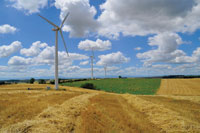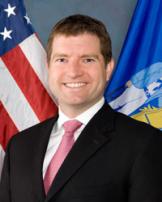Driving along Wisconsin’s scenic highways, there’s never been any doubt that it is a “green” state, known for its rolling hills, valleys and farms. However, as the dairy state surges forward into the 21st century, its intention is to become known for another sort of “green” as well - as a leader in the U.S. in exploring alternative energy sources. And it’s succeeding.
 Windmills dot the hillsides of numerous Wisconsin counties, providing clean, safe, efficient energy to thousands. Public and private enterprises are all jumping on the bandwagon – Madison College’s satellite Fort Atkinson campus recently installed a wind power system which provides all of the energy used in the building and on the grounds – selling its excess energy to the city.
Windmills dot the hillsides of numerous Wisconsin counties, providing clean, safe, efficient energy to thousands. Public and private enterprises are all jumping on the bandwagon – Madison College’s satellite Fort Atkinson campus recently installed a wind power system which provides all of the energy used in the building and on the grounds – selling its excess energy to the city.
Since taking office in January of 2003, Governor Jim Doyle has made alternative energy and environmental improvement issues top priorities. He knows that every dollar saved by reducing energy costs through energy efficiency makes Wisconsin’s manufacturers more competitive and profitable by lowering production costs.
The production requirements for renewable energy component manufacturing draw heavily on the skills represented in the state’s traditional manufacturing base. Wisconsin leads the nation in the percentage of the population employed in the manufacturing sector and also leads the nation in green job creation potential as a percentage of total population. The marriage of manufacturing and green technology is a natural.
The demand for U.S.-based renewable energy component manufacturing will continue to grow for the foreseeable future, and Wisconsin businesses are positioned to supply this demand thanks to Governor Doyle’s new $100 million Green to Gold fund. A play on the Green Bay Packers’ colors, the fund is an ironclad commitment to Wisconsin’s manufacturers that the state is focused on creating and retaining jobs and increasing manufacturers’ competitiveness in the new economy.
The Green to Gold (G2G) fund creates a one-stop shop—a single point of entry for manufacturers that aligns federal dollars, existing and future state resources to ensure that as industrial manufacturers create or retain jobs they achieve energy efficiency, use renewable energy, and make products that support a green economy.
Many of Wisconsin’s industrial manufacturers value sustainability, but lack the resources to jump start their efforts. The G2G fund addresses this lack of capital for energy efficiency, renewable energy, and green retooling initiatives.
The G2G fund assists companies as they implement energy efficiency or renewable energy measures in their facilities to enhance their competitiveness and create or retain jobs, retool their existing facilities to manufacture products that support the green economy, and expand or establish domestic clean energy manufacturing operations. It includes a $1.75 million 12-month pilot program that partners with the Wisconsin Manufacturing Extension Partnership (WMEP) to assist small- and mid-sized manufacturers in achieving profitable sustainability.
The fund also positions Wisconsin as an early adopter of the proposed federal IMPACT program, increasing the state’s chances of securing new federal dollars that can further support the G2G fund’s efforts.
The American Recovery and Reinvestment Act of 2009 also provided significant funding for clean energy initiatives. Among them is the State Energy Program (SEP), which provides funding to states to address energy priorities and to adopt emerging renewable energy and energy-efficient technologies. This initiative is a key part of the Obama Administration's national strategy to support job growth, while making a historic down payment on clean energy and conservation.
Wisconsin will strategically deploy $85 million in SEP-ARRA funds to support clean energy business development. Governor Doyle has directed that projects funded from SEP-ARRA dollars are both effective and enduring. A key objective with SEP-ARRA funds is to leverage private sector investment.
Creation of jobs in the short term is the immediate goal of SEP-ARRA; but, in addition, the program goals are to invest in projects that will ensure not only short-term job creation, but development of businesses that will create clean energy jobs for decades.
Specifically, the program will target low-interest loans to businesses that promote:
Major renewable energy production projects.
The manufacture of clean energy products.
Advanced manufacturing of clean energy components.
Retooling to provide component parts and other critical needs for a successful, totally integrated supply chain.
Improving industrial users’ competitiveness through energy efficiency and renewable energy deployment.
Some examples of recent successful energy projects in Wisconsin include:
WE Energies/Domtar $250 million biomass plant in Rothschild which created 400 construction jobs and 150 permanent ones.
PDM Solar, Inc., Wausau, provides air conditioning for large commercial, retail, and industrial operations during peak electrical demand, greatly reducing the use and expense of electricity.
Cardinal Solar Technologies, Mazomanie, 180,000-sq.-ft. facility designed to grind, drill and heat-strengthen or “temper” the glass used in making photovoltaic solar panels which created 54 new jobs.
Johnson Controls-Saft Advanced Power Solutions LLC, Glendale, jointly developing advanced materials, components and processes for manufacturing lithium-ion batteries for use in hybrid and electric vehicles. The company won the contract to supply batteries for Ford’s Focus hybrid.
At the Department of Commerce, we’re looking for opportunities to fund projects in this exciting new area, as well as others in traditional businesses. We hope you’ll take a look at all we have to offer.

